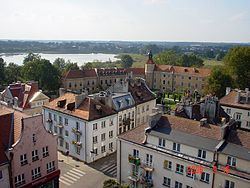Town rights 1327 Area 12.17 km² Local time Sunday 9:37 AM | Established 13th century Time zone CET (UTC+1) Population 14,497 (2006) | |
 | ||
Weather 2°C, Wind NW at 24 km/h, 95% Humidity Voivodeship Warmian-Masurian Voivodeship | ||
Morąg [ˈmɔrɔŋk] (German: Mohrungen ) is a town in northern Poland in Ostróda County in the Warmian-Masurian Voivodeship about 60 km (37.28 mi) south of the Polish - Russian border. The nearest city is Olsztyn, 44 km to the southeast.
Contents
Map of Mor%C4%85g, Poland
History
The settlement existed as an Old Prussian town known under the name of Mawrin, Maurin or Morin. A new town was built on its place by the invading Teutonic Knights after they destroyed the original settlement. It was given the name Mohrungen and in 1327 attained Kulm law from Hermann von Oettingen. The original inhabitants of the town were emigrants from the southern Harz in central Germany. The War between the Teutonic Order and Poland saw the town incinerated completely in 1414. Mohrungen was occupied by the Grand Duchy of Lithuania and the Kingdom of Poland from 1410 to 1461.
Mohrungen was on a shipping commerce line connecting Truso with harbors at the Black Sea. Agriculture and commerce was the primary occupations in the town. It was known as a cattle and grain market.
From 1525 to 1701 Mohrungen was part of Ducal Prussia and became part of the Kingdom of Prussia in 1701. It was the seat of the district administration of Landkreis Mohrungen since 1752. An earthquake struck the town in 1818. Until 1945 Mohrungen belonged to Germany. After World War II the local populace was expelled and the town became part of Poland as Morąg.
From May 2010 to 2011 the town was the garrison of a US Army Patriot Missile Defense battery.
Sights
After a fire in 1697 only the castle and the church, which was restored and rebuilt several times, survived. Following World War II in 1945 fires burnt about 45% of the town. Only the outer walls of the town hall remained.
Population
Famous residents
Religion
Pastoral activity in the town is the Roman Catholic Church and the Pentecostal Church - Protestant community on the nature of the Gospel, as well as the Greek Orthodox Church.
